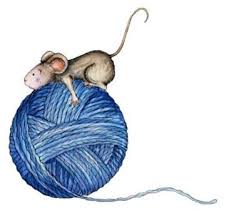Test
Hello, my dear ladies!
I've found a quite interesting test for knitters.
Hope, that you'll like it.
Write your answers in the comments and I'll post the correct answers tomorrow.
1. Wool is the most common fiber used in hand knit socks. It's so popular because of several properties that make it ideal for this purpose. Which of the following is NOT a reason for wool's popularity among sock knitters?
a. It is the only fiber other than silk that can be spun into a thin enough yarn for socks.
b. It pulls moisture away from feet.
c. It is naturally elastic.
d. It is a breathable fiber, trapping heat while allowing air to circulate.
2. If you examine a sock (go ahead - you know you want to!), you'll notice that it's basically a tube with a bend in it. There are several ways to create that bend for your heel. Which of the following is NOT a common name for a type of sock heel construction?
a. Dutch heel
b. peasant heel
c. short row heel
d. snake heel
3. It's generally a good idea to knit a sock with "negative ease". What is negative ease, and why is it important?
a. Negative ease means knitting the sock in the most difficult (least "easy") way possible. This is important because it builds character.
b. Negative ease means a really loosely knit fabric. It's important because it will be softer than a dense fabric.
c. Negative ease means the circumference of the sock is smaller than the circumference of your leg and foot. It's important because it will help keep the sock from slouching and shifting.
d. Negative ease is a method of knitting a sock starting with the toe. It's important because if you knit the toe last instead of first, you'll be left with a big hole
4. Which of the following is a popular brand of sock yarn?
a. Lorna's Laces Shepherd Sock
b. Wanda's Wools Twinkle Toes
c. Fannie's Fibers Flock a-Foot
d. Acrylic Annie's Sir Sweats-a-Lot Socks
5. What is the name of the technique used to close the toe in many sock patterns?
a. ketchup stitch
b. kitchener stitch
c. knipper stitch
d. knicker stitch
6. This pattern combines columns of knit and purl stitches to create a simple but very stretchy sock.
a. frogging
b. ribbing
c. intarsia
d. garter
7. I prefer to knit my socks starting with the leg and ending with the toe. Some people prefer to knit toe-up socks. There are a few popular methods of casting on for such socks. True or False: One of the methods is called the "figure 8 cast on."
a. True
b. False
8. There are several ways to actually knit tubes for socks. Which of the following is NOT a common method/tool for knitting socks.
a. the 2-circular method
b. knitting in the round using doublepointed needles
c. icord tube
d. magic loop
9. While it certainly varies from sock to sock, about how many yards of yarn do you think there are in a pair of adult sized socks knit from fingering weight (sock weight) yarn?
a. 40
b. 400
c. 4,000
d. 40,000
10. What is the best way to make sure your hand knit socks stand the test of time?
a. all of these choices
b. Air dry your socks, instead of throwing them in the dryer.
c. Use a yarn with nylon content, or reinforce the sock toes and heels with nylon thread.
d. Knit your socks at a relatively tight gauge.
